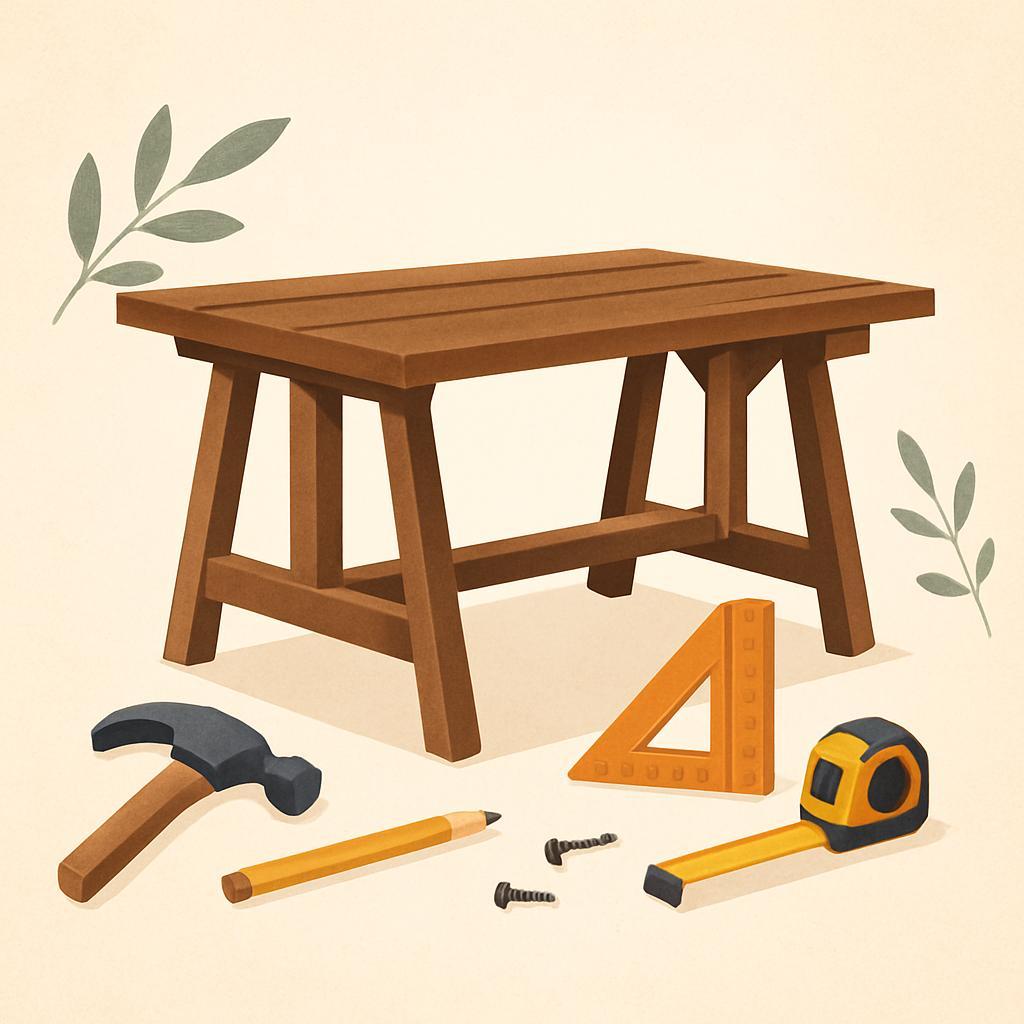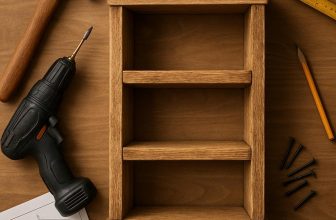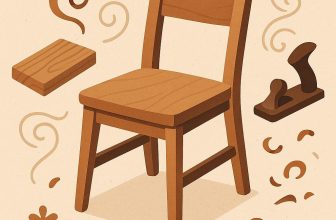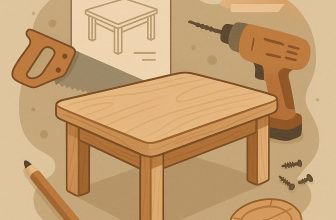
One stubborn plank,a patient plan,and a few precise cuts-the result is a farmhouse table that feels like it's always been there. For woodworking enthusiasts, it's a proving ground: a project that tests layout accuracy, joinery choices, and finish work while yielding a durable, timeless piece. In this step-by-step guide, you'll learn how to select stock, size a cut list, choose reliable joinery, and assemble with care.You'll also gain tips on finishing, distressing for character, and maintenance to keep the table sturdy for years. Ready to turn simple timber into something lasting?
Designing a Farmhouse Table for Your space and Style
Begin by mapping your room: measure length, width, and how doors or windows impact the space. Think about how you move around the table and where you'll place chairs.decide on a shape that fits your flow-rectangular is classic for most rooms, while square works beautifully in cozier nooks and extendable designs offer adaptability for gatherings. Aim for a footprint that leaves at least 3 feet of clearance on all sides for chairs to pull out and people to pass by.
Material and style sets the mood. For a timeless farmhouse vibe, opt for reclaimed wood or a live-edge board with natural variation. choose an edge that matches your room-a crisp square edge for a modern touch, or a breadboard end option to curb warping. Consider joinery that balances durability with ease of assembly: mortise-and-tenon for lasting strength, or modern pocket-hole joints if you're building with power tools and patience. The legs matter too: chunky turned legs or sturdy square posts can anchor the look while leaving ample knee room.
Use a rapid reference for size and proportion. The table below shows practical targets to help you translate space into measurements.
| Aspect | Recommendation |
|---|---|
| Length | 72-96 in (6-8 ft) for 6-8 seats |
| Width | 28-40 in |
| Height | 28-30 in |
| Leg clearance | 24 in from edge to knee |
Finish and maintenance flow naturally from your material choice. A simple oil or matte polyurethane protects the surface without dulling grain. If you prefer a softer, rustic glow, a beeswax-based finish adds warm patina. Test several sample swatches on a scrap board to ensure color, sheen, and wear match your space. plan for installation: secure a sturdy apron or a trestle base, check ceiling and door clearances, and mock-up seating with the specific chairs you own to confirm comfort and traffic flow.
Get instant Access to 16,000+ Woodworking Plans →
Choosing Materials and Tools for a Durable Farmhouse Table
Durability starts with material choice. For a farmhouse table that will see daily use, choose solid wood that resists denting and warping. Traditional hardwoods like red oak, hard maple, ash, and walnut bring strength and a timeless grain, while still finishing well. If budget is tight, high-quality pine or poplar can work when you seal and maintain it properly, but expect more movement with seasonal humidity. Look for boards that are kiln-dried and have a moisture content in the single digits to low teens. Check each plank for straightness, flatness, and minimal warp, and prefer edge-glued panels or well-joined boards that can handle expansion. Plan ahead for movement by opting for joinery that allows it, such as breadboard ends or floating panels, rather than a rigid single-piece top.
Tools you'll rely on to translate that material into a solid surface are the right investment. Build with a focused set of dependable tools rather than chasing every gadget. Core gear includes a table saw for sizing stock and straight edges, a miter saw for precise crosscuts, a router for edge profiles and joinery, a cordless drill/driver for pilot holes and assembly, a random-orbit sander for smooth finishes, several clamps (bar and C-clamps) for glue-ups, a few chisels, a square, measuring tape, and sharp blades and bits. Safety comes first: wear eye protection and a dust mask, keep blades sharp, and clamp work securely before cutting. With these basics, you can cut, drill, and assemble cleanly and efficiently, setting up your shop for years of use.
| Tool | Use | Notes |
|---|---|---|
| Table saw | Ripping and sizing stock | Keep blade sharp; use push sticks |
| Miter saw | Precise crosscuts | Use stops for repeat cuts |
| Router | Edge profiles and joinery | Take light passes |
| Drill/driver | Pilot holes and assembly | Two-speed or torque control |
| Clamps | Glue-ups | Keep pieces flat and secure |
Finish and joinery decisions determine how long your table stays sturdy and stunning. For the top, apply a durable, even finish that stands up to spills and heat. Options range from oil-based polyurethane or water-based polyurethane to a hand-rubbed tung oil look; choose a satin or low-sheen sheen to match a farmhouse vibe. Before finishing, dry-fit your pieces, sand to at least 180-220 grit, remove all dust, then apply thin coats with light sanding between coats. In assembly, favor joinery that allows wood movement: mortise-and-tenon or dowels for the legs and rails, and consider breadboard ends or floating panels for the top. If you use pocket-hole screws,supplement with glue and care to keep the surface flush. Finish with quality hardware-sturdy leg brackets or hidden brackets to keep legs square, and use appropriate fastener lengths: such as, 1-¼” screws for thinner rails and longer screws for thicker stock.
get Instant Access to 16,000+ Woodworking Plans →
Planning Joinery and Construction for a Sturdy Farmhouse Table
starts in the shop with a clear map of how each piece will connect. Begin by selecting straight-grained stock, aiming for boards that run the length of the table for the tabletop, and choose legs that are at least 1.75-2 inches thick for stability. Plan the grain direction to minimize warping; run the grain consistently across rails and legs. Plan the grain and joints carefully to ensure the table remains tight under daily use, and sketch a simple layout that shows where the legs, aprons, and top will join, so your chosen joinery can be executed cleanly.
Choose joinery that balances strength with ease of assembly. For the legs-to-apron connections,mortise-and-tenon joints with drawbolts provide robust,long-lived strength. If you prefer a faster build,you can use dowels or biscuits for alignments,but plan for occasional re-tightening. For the tabletop,consider breadboard ends or a glue-up with proper alignment to keep panels flat. The following quick reference helps you pick the right method for each connection:
| Joinery | Best For | Pros | Cons |
|---|---|---|---|
| Mortise-and-Tenon | Legs to rails | Very strong, long-lasting | Requires precise cutting |
| Drawbolts (through-tenons) | Frame connections | Adjustable, secure | Hardware visible |
| Biscuit or dowel | Panel alignment | Quicker setup | Less rigid than tenons |
| Breadboard ends | Tabletop stability across panels | Keeps panels flat | More setup steps |
Dry-fit all joints before gluing. Mark centers, ensure squareness with a carpenter square, and check with a framing square along the diagonals. use a light chamfer on the underside of rails to avoid binding, and pre-drill screw holes to minimize splitting. When glue is applied, clamp evenly and use wedges to maintain true angles. For a farmhouse top, aim for a 1.75-2 inch thickness assembled from solid boards to reduce seasonal movement, and align the grain on adjacent boards to minimize gaps and create a seamless surface.
plan for finish and movement. Wood expands and contracts with humidity, so leave small gaps where boards meet the tabletop panel and fasten the top to the frame with screws that allow some movement.Apply a durable finish such as oil or polyurethane and maintain by wiping spills promptly. If you're anchoring the table to an uneven floor, consider anti-slip pads to reduce wobble and check joints annually for looseness. With this thoughtful approach, your farmhouse table will stay sturdy and inviting for years to come.
Get Instant Access to 16,000+ Woodworking plans →
Step by step Assembly Guide for a Classic Farmhouse Table
Begin with a clean, level workspace and a precise cut list. Dry-fit all major components on the floor before any glue hits timber. Align the two end aprons with the legs and check for square at the corners. This pre-assembly checkpoint catches warps or miscuts early and saves headaches later in the process. Have your plan in front of you,and mark all components with their orientation to avoid mix-ups.
Next,assemble the base. Start with the legs and side aprons, fastening with sturdy joinery-pocket screws or mortise-and-tenon are both reliable in farmhouse tables. Apply a thin bead of wood glue to joints, clamp firmly, and drive screws once the glue tacks.Keep the assembly flat on the floor or a plywood sheet to prevent twisting. Ensure a consistent gap between rails and legs and double-check that the corners measure square as you tighten.
Attach the center and end rails to form the apron frame, then support the tabletop. If using pocket-hole fasteners, space them every 12-16 inches and countersink to hide the heads. Install any battens or supports under the tabletop to control sag, then place the tabletop boards with the grain running across the width for a classic look. Leave a small expansion gap (about 1/8 inch) between boards if you expect humidity fluctuation,and clamp while the glue dries to keep edges flush.
Finish and fine-tune. Sand through the grits 120 to 220,remove dust,and apply your chosen finish in thin coats.Do a final wipe-down and test the table by applying weight near the center and edges to confirm no wobbles. Protect the surface with a clear polyurethane or oil finish, and periodically check the hardware as seasons change.
| Item | Purpose |
| Pocket screws (1-1/4″) | Attach aprons to legs |
| Wood glue | Increase joint strength |
| Tabletop screws or long wood screws | Secure tabletop to battens |
| Finish (poly or oil) | Protect and enhance grain |
Get Instant Access to 16,000+ Woodworking Plans →
Finishing Techniques to Achieve Texture and Character on a Farmhouse Table
Texture and character on a farmhouse table don't come from a single trick; they emerge from a intentional finishing sequence that honors the wood's grain. Start with a careful assessment of the board and plan your sanding progression to open the pores just enough. Begin with 120 grit to mellow tool marks, move to 180 for refinement, then 220 for a smooth surface.If you crave more tactile texture, a light wire-brush pass along the grain can lift tiny fibers and catch light. For depth without losing grain, mix a glaze with a touch of the stain and work it into the grain with a rag, then wipe away the excess so the natural texture remains readable.
Once texture is established, decide how much color and depth you want. A warm oil- or water-based stain will enhance the grain; a gel stain brushed on and wiped off can sit in the crevices for pronounced shadows. Glazes are your friend for aged character: apply in thin coats, then blot and wipe to leave soft, irregular darkness in the recesses. Seal the look with a topcoat that suits your space: oil-based poly for a classic amber glow or water-based poly for a crisper, modern feel. Between coats, sand lightly with 320-400 grit to keep the texture crisp, then finish with a wax or satin topcoat to soften edges and give a hand-finished feel.
For quick reference, here is a compact table of finishing moves you can try.
| Technique | Effect | Tip |
|---|---|---|
| Distressing | Aged texture that highlights grain | Lightly rub with a damp rag after glaze |
| Wire Brushing | Raised grain and tactile surface | Work along the grain with a stiff brush |
| Glazing | Depth in recesses and shadows | Wipe in thin passes, wipe clean quickly |
| Topcoat (oil-based) | Warm amber glow and durable finish | Apply in thin coats, sand between coats |
| Topcoat (water-based) | clearer finish and quicker cure | Thin coats, minimize bridging with smooth strokes |
To keep the look intact over years of use, care matters. Clean with a soft cloth and mild soap, wiping in the direction of the grain. Address spills promptly with a damp cloth to prevent staining, and reapply a protective topcoat when water no longer beads on the surface. If your kitchen or dining area is humid or sunlit, consider a satin or eggshell sheen to reduce glare while preserving the texture. With routine maintenance and a measured touch during finishing, the table will age gracefully, picking up character without sacrificing durability.
Get Instant Access to 16,000+ Woodworking plans →
care and Maintenance for a Long Lasting Farmhouse Table
to keep a farmhouse table looking timeless, treat the finish with respect and consistency. Your finish choice-whether it's hard-wax oil, polyurethane, or a penetrating oil-will guide how you clean and protect the surface. Regularly dust with a soft cloth and blot spills immediately to prevent stains.Avoid abrasive cleaners that can dull the finish, and aim for a stable humidity level (roughly 40-50%) to minimize wood movement over the years.
Daily habits form the backbone of long-lasting beauty. Wipe the surface after meals with a clean microfiber cloth, wipe up liquids quickly, and consider applying a fresh coat of the finish when the surface begins to look flat or tacky. In addition, the quick care reference below provides a practical guide for when to perform each task.
| Dust/Wipe | Weekly | Soft cloth |
| Spills | As needed | Blot, don't rub |
| Oil/wax | Every 6-12 months | Follow finish guidelines |
| Refinish | Every 3-5 years | Assess wear |
Protect the table during use. Always use coasters, placemats, and cutting boards to shield from heat and knife marks. Avoid leaving hot pots directly on the wood and use felt pads under decorative items. Keep sunlight to a minimum,as UV can fade the wood color over time.
Seasonal upkeep keeps the table fit for everyday life. Inspect the finish for micro-scratches or tiny cracks and address them promptly-lightly sand and reapply the finish as needed. If the wood develops pronounced splits or warping, consult a professional rather than attempting a DIY repair. Maintain a pleasant climate in the room and consider a dehumidifier in damp spaces.
Get Instant Access to 16,000+ Woodworking Plans →
Q&A
What type of wood is best for a farmhouse-style table?
For a sturdy farmhouse table, choose solid hardwoods like oak, maple, or reclaimed pine.Look for straight grain, good stability, and moisture tolerance for a kitchen environment. Each option offers a different balance of durability,look,and budget.
How do I choose the right dimensions for my space?
Measure the dining area and the chairs, then leave about 36 inches of clearance around the table for easy movement.Aim for a table height of 28-30 inches; use the seating capacity to guide length (roughly 6 people at 72 inches, 8-10 at 96-110 inches). Adjust for leg room and entryways to avoid crowding.
What tools and safety tips do I need to complete this project?
Gather essential tools: a saw,drill,sander,clamps,measuring tool,and a router for edge details. Prioritize safety: wear eye and ear protection, use a dust mask, clamp pieces securely, and unplug tools when changing bits or blades. Keep your workspace tidy to prevent accidents.
How do I achieve a distressed,rustic finish without overdoing it?
Start with a light stain or paint base to show grain,then apply a glaze or lighter color to create depth. Wipe, sand edges and beveled corners softly to mimic wear, focusing on high-traffic areas. Finish with a durable topcoat like polyurethane or wax, depending on the desired sheen and use.
In Retrospect
Ultimately,the key takeaway is to let simplicity guide your build: deliberate planning,steady hands,and a finish that respects the wood's grain.When you slow down to measure, dry-fit, and test fit, the table becomes more than a surface-it becomes a record of decisions and care.For woodworking enthusiasts, this project matters because it builds confidence without demanding exotic tools, and it yields a sturdy, timeless piece that ages with you.So pick up your tools, try the steps, consult other guides, or adapt the plan to your space.Your workshop awaits-steady hands, patient cuts, and a table that feels like home.







This looks amazing, I can’t wait to try building my own farmhouse table following your guide!
I’ve always wanted a farmhouse table! Your step-by-step instructions seem super helpful, can’t wait to get started!
This guide is fantastic! I’ve been looking to add a personal touch to my dining area, and a farmhouse table would be perfect. Thanks for sharing these detailed steps!
I’m so excited to see this guide! I’ve been wanting to create a warm and inviting space in my home, and a farmhouse-style table seems like the perfect project to bring that vision to life. Thank you for the clear instructions!
This guide is exactly what I needed! I’ve been wanting to create a cozy, farmhouse vibe in my home, and making my own table seems like a great project to tackle. Thanks for sharing such easy-to-follow instructions!
This is just what I needed! I’ve been wanting to add a farmhouse table to my dining room, and these step-by-step instructions make it seem so manageable. Thanks for sharing your expertise!
I’m thrilled to see this guide! I’ve been searching for a way to enhance my dining space, and building my own farmhouse table sounds like an amazing project. Thank you for the detailed steps; I can’t wait to dive in!
This guide is a game changer! I’ve always admired farmhouse tables for their charm and character, and now I feel empowered to create one myself. The step-by-step approach is super helpful-thank you for making this project accessible!
This guide is fantastic! I’ve always loved the look of farmhouse tables, and now I feel ready to take on this DIY project. The step-by-step instructions are super clear and inspiring-can’t wait to get started!
I’m so excited to try this out! I’ve always admired the rustic charm of farmhouse tables, and with these clear steps, I feel confident I can make one myself. Thanks for breaking it down; it’s truly inspiring!
This guide is incredible! I’ve always loved the warmth and character of farmhouse tables, and seeing these detailed steps has motivated me to finally try building one myself. Thank you for such a clear and approachable tutorial!
This guide is just what I needed! I’ve always appreciated the beauty of farmhouse tables, and with these straightforward instructions, I’m eager to take on the challenge and create one for my home. Thanks for sharing such an easy-to-follow tutorial!
I’m thrilled to see this guide! I’ve always wanted a farmhouse-style table to add warmth to my dining space, and with these clear instructions, I finally feel ready to tackle this project. Thank you for making it so approachable and inspiring!
I’m really excited about this guide! I’ve always wanted a farmhouse-style table in my home, and the detailed instructions make it feel achievable. Thanks for providing such a great resource-can’t wait to get started on my own project!
I can’t express how grateful I am for this guide! I’ve long admired farmhouse-style tables for their beauty and practicality, and your step-by-step approach makes the project feel totally doable. I’m ready to roll up my sleeves and get started-thank you for the inspiration and guidance!
This guide is a game changer! I’ve been dreaming of a farmhouse-style table for ages, and your clear instructions make it feel like I can finally bring that dream to life. Thanks for sharing such a valuable resource-I’m so excited to get started!